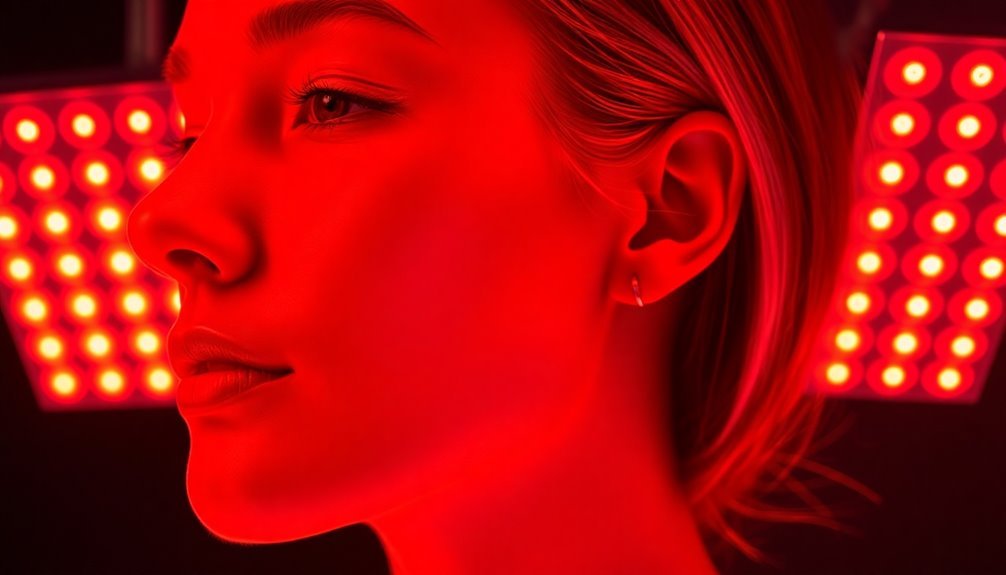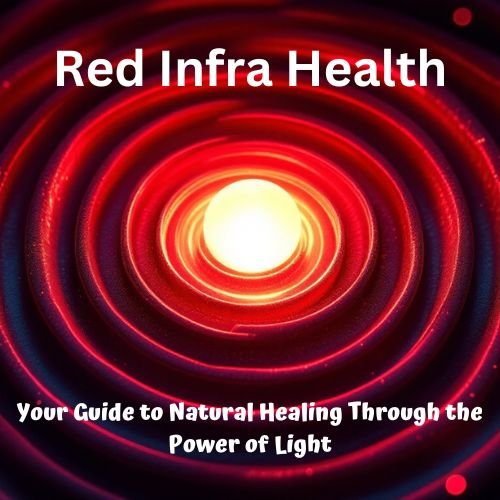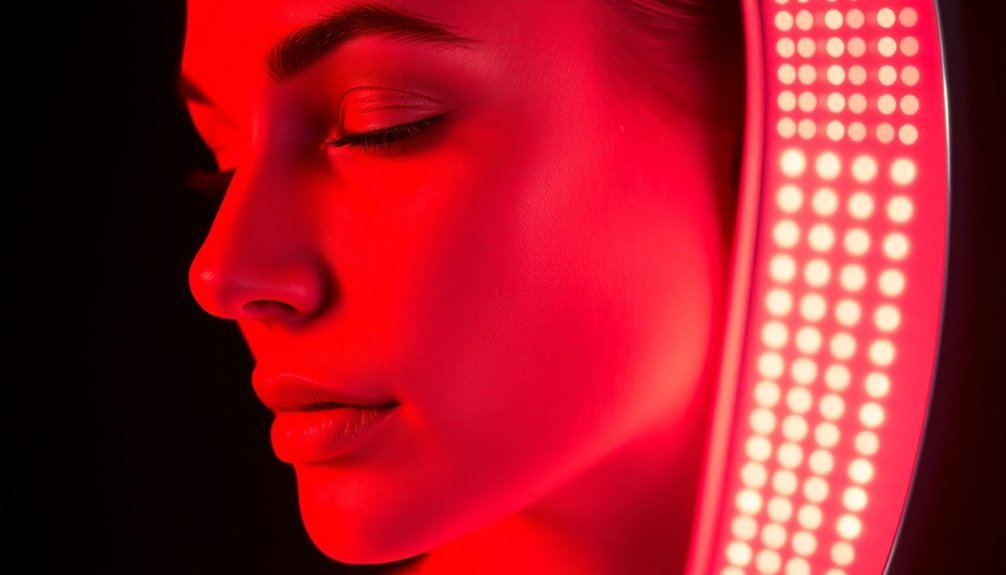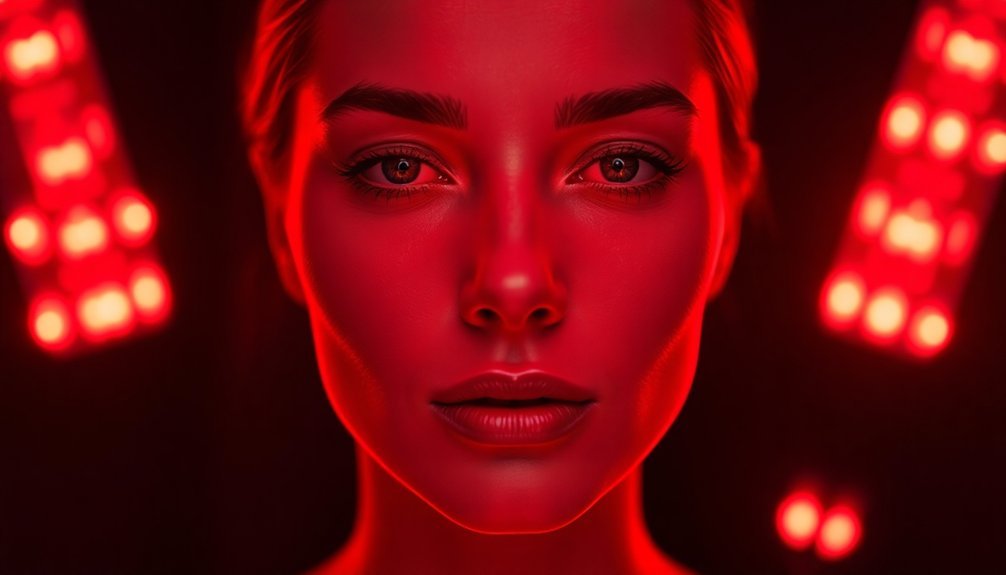LED light therapy can substantially boost your body's natural collagen production by up to 31%, backed by extensive clinical research. Using specific red and near-infrared wavelengths, LED therapy penetrates your skin layers to stimulate fibroblast cells, which triggers increased collagen and elastin production. You'll see measurable improvements in skin texture, with studies showing up to 36% reduction in wrinkles and 19% increase in elasticity. It's a non-invasive, FDA-cleared treatment that requires no downtime and works for all skin types. The science behind this breakthrough technology reveals even more impressive benefits for your skin's health and appearance.
Understanding LED Light Therapy

LED light therapy represents a groundbreaking advancement in skincare technology that harnesses specific wavelengths of light to enhance skin health and appearance.
When you undergo LED therapy, you'll experience a non-invasive treatment that uses light-emitting diodes to deliver targeted wavelengths deep into your skin layers, triggering natural healing responses without any downtime.
The treatment works through different colored lights, each serving a unique purpose. You'll find that red light stimulates collagen production, helping reduce wrinkles and improve elasticity, while blue light targets acne-causing bacteria and controls oil production. Near-infrared light penetrates the deepest, promoting both collagen and elastin production while enhancing your skin's texture. Each session typically takes 20 minutes to complete.
What makes LED therapy particularly effective is its versatility in treating multiple skin conditions simultaneously. You can address concerns ranging from rosacea and sun damage to psoriasis and eczema.
Clinical studies have consistently demonstrated the therapy's effectiveness, particularly in treating acne vulgaris and promoting skin rejuvenation. The best part? You won't experience adverse effects, as research shows it's both safe and well-tolerated, making it an ideal choice for ongoing skin maintenance and improvement.
The Science Behind Collagen Production
Deep within your skin's layers, a complex biological process orchestrates the production of collagen, the protein responsible for maintaining your skin's strength and elasticity. This process begins when specialized cells called fibroblasts activate specific genes through transcription, converting DNA into RNA. These crucial steps occur in the extracellular matrix, where the collagen formation takes place.
The RNA then serves as a template for assembling amino acids into procollagen, which consists of three intertwined peptide chains.
Your body's ability to produce collagen depends on several essential factors. After your mid-20s, natural collagen production starts declining. Environmental factors like sun exposure, smoking, and excessive alcohol can damage existing collagen fibers.
However, you can support collagen synthesis through proper nutrition, including foods rich in glycine, proline, and hydroxyproline.
LED light therapy offers a scientifically-proven method to boost your collagen production. Red and near-infrared wavelengths penetrate your skin at different depths, stimulating fibroblast activity. These light waves trigger your cells' natural collagen-producing mechanisms without damaging your skin's surface.
When combined with proper nutrition and lifestyle choices, LED therapy can help maintain your skin's structure and combat age-related collagen loss through non-invasive stimulation of your body's natural processes.
Clinical Research and Results

Extensive clinical research has validated LED therapy's effectiveness in stimulating collagen production and improving skin appearance. Studies show remarkable results, with up to 31% increase in type-1 procollagen and an 18% decrease in MMP-1, a protein that breaks down collagen.
You'll find compelling evidence in split-face clinical trials, where 87% of participants experienced reduced wrinkle severity after 12 treatments. The therapy is FDA-cleared for safety, ensuring its reliability for home and professional use.
The research demonstrates up to 36% reduction in wrinkles and a 19% increase in skin elasticity. What's more, over 90% of participants showed measurable improvements in skin texture and rhytid depth.
When you look at the biochemical effects, LED therapy at 633nm wavelength consistently stimulates collagen synthesis while decreasing collagen breakdown. Histological examinations reveal highly activated fibroblasts surrounded by abundant elastic and collagen fibers. The therapy also increases TIMP-1 and TIMP-2 levels, which help stabilize collagen in your skin.
Safety data is equally impressive – you won't experience downtime or significant adverse effects. Clinical studies report high tolerance rates, with 85% of subjects showing reduced UV-B induced redness, making LED therapy a reliable option for collagen enhancement.
Treatment Methods and Applications
Various treatment methods make LED therapy accessible for both professional and home-based collagen stimulation. You'll find options ranging from professional LED machines in dermatology offices to convenient at-home devices like facial masks and light wands. The use of eye protection is essential during all LED treatments to prevent potential eye damage or sensitivity.
The key to effective treatment lies in delivering the right energy level, typically between 2-10J/cm2, which can be enhanced through pulsed light application.
Your treatment plan will likely incorporate different wavelengths targeting specific skin layers. Red and near-infrared lights penetrate deeper to activate fibroblasts, stimulating collagen and elastin production. You can combine these with other wavelengths for thorough results – blue light treats surface concerns like acne, while amber and green address different skin issues.
For ideal results, you'll need multiple sessions, whether you're receiving in-office treatments or using home devices. Your practitioner might recommend combining LED therapy with photosensitive drugs like 5-aminolevulinic acid for enhanced results.
This non-invasive approach requires no downtime, making it a practical choice for ongoing skin rejuvenation. Treatment customization is essential, so you'll work with professionals to determine the most effective combination of wavelengths for your specific skin concerns.
Skin Rejuvenation Benefits

LED therapy will visibly plump your skin through enhanced fibroblast activity that boosts collagen production by up to 340% when using face-conforming masks.
You'll experience advanced cellular repair as the red light stimulates your mitochondria and activates essential growth factors like TGF-β, leading to improved skin structure and function. The combination of wavelengths using both 633nm and 830nm LEDs delivers optimal rejuvenation results with 52% of patients seeing marked improvements.
Clinical studies confirm these benefits, showing up to 36% reduction in wrinkles and significant improvements in skin elasticity, with 91% of users reporting better skin tone and texture.
Enhanced Skin Plumping Effect
Scientific research confirms that red light therapy delivers remarkable skin-plumping effects through its ability to penetrate deep into the dermis. When you receive LED treatments operating at wavelengths between 630-700 nanometers, you'll experience enhanced cellular activity that directly impacts your skin's volume and firmness.
Studies involving 90 patients demonstrated that over 90% saw visible improvements in just 4 weeks of treatment. LED light therapy can be safely combined with other skin treatments like creams and facials for enhanced results.
The therapy works by triggering your body's natural collagen production mechanisms while stimulating the release of cytokines, which are essential for cell communication and repair. You'll notice significant improvements in your skin's elasticity and overall texture as the light energy boosts ATP production, fueling vital cellular processes.
- Your skin cells absorb the red light waves, creating a cascade of regenerative effects that plump up hollow areas
- The increased collagen production fills in fine lines and wrinkles from within
- Your skin's surface becomes noticeably firmer and more volumized, creating a natural, youth-restoring effect
Regular treatments will help maintain these results, with most people seeing peak improvements after consistent monthly sessions.
Advanced Cellular Repair Mechanisms
Deep within your skin cells, advanced cellular repair mechanisms spring into action when exposed to therapeutic LED wavelengths. When red and near-infrared light penetrate your skin's layers, they trigger your mitochondria to produce more ATP, the essential energy source that powers cellular repair processes.
This boost in cellular energy drives the production of key growth factors that accelerate tissue regeneration and healing. The therapy also enhances your skin's antioxidant defenses, protecting cells from harmful free radical damage.
You'll experience enhanced collagen and elastin production as the light therapy activates fibroblast growth factors in your deeper skin layers. These proteins are essential for maintaining your skin's firmness and elasticity.
The process works similarly to photosynthesis, where your cells convert light energy into biological fuel that powers repair mechanisms.
The therapy's effectiveness extends beyond basic repair, as it specifically targets inflammatory skin conditions like rosacea, psoriasis, and eczema. Your skin's natural healing abilities are amplified through increased ATP production, leading to faster wound healing and reduced scarring.
As these cellular repair mechanisms optimize your skin's regenerative processes, you'll notice improvements in texture, tone, and overall skin health.
Clinical Wrinkle Reduction Results
These cellular repair processes directly translate into measurable wrinkle reduction results. Clinical studies show that LED therapy can reduce wrinkles by up to 36% while increasing skin elasticity by 19%. You'll find the most dramatic improvements around your eyes, where the treatment proves particularly effective for diminishing periorbital wrinkles. The therapy's non-invasive nature means you can resume normal activities immediately after treatment.
The visible changes you can expect include:
- Smoother, more refined skin texture with 82% of patients reporting enhanced smoothness
- More even skin tone, with 91% of subjects noting improvements in their complexion
- Significant reduction in fine lines, particularly in the delicate eye area
What's particularly compelling is that these aren't just surface-level changes. Microscopic examination reveals substantial increases in both collagen and elastic fibers throughout the treated areas.
When combining specific wavelengths (830 and 633 nm), you'll likely see the best results, with over half of patients achieving 25-50% improvement in their photoaging scores by week 12.
The treatment's effectiveness is further validated by histological studies showing activated fibroblasts surrounded by new collagen formation, without any adverse effects reported in control groups.
Safety and Treatment Guidelines
Maintaining safety during LED light therapy is essential for best results and avoiding potential complications.
While LED therapy is generally safe for all skin types and colors, you shouldn't use it if you're taking Accutane or using products that increase light sensitivity. If you have active rashes, skip treatments unless your doctor specifically approves them for conditions like psoriasis.
Before starting treatment, confirm your skin is clean, dry, and product-free. Position the device within one inch of your treatment area for maximum results. Medical-grade eye protection must be worn during all treatment sessions to prevent eye damage.
You can safely use LED therapy for up to 30 minutes daily, but typical protocols call for 2-3 sessions weekly over four weeks. After treatment, you're free to apply your regular skincare products, including serums and moisturizers.
For specific concerns, follow targeted protocols. If you're treating aging skin, focus on red light therapy 2-3 times weekly. For acne, combine blue and red light treatments 2-3 times weekly.
Hair and scalp treatments work best every other day for 16 weeks. While side effects are rare, watch for signs of inflammation, redness, or tenderness, and discontinue use if these occur.
Combining LED With Other Treatments

By combining LED light therapy with other skincare treatments, you'll maximize your results and enhance recovery times. Studies show that red LED light substantially reduces inflammation and redness while accelerating healing through increased collagen production. Non-ultraviolet rays make this treatment exceptionally safe to combine with other skincare procedures.
When you pair LED therapy with treatments like chemical peels or microneedling, you'll experience faster recovery and improved skin texture.
Your skin's ability to absorb products improves dramatically when you incorporate LED therapy into your skincare routine. The increased collagen production and enhanced skin elasticity make your skin more receptive to active ingredients, leading to better overall results.
Three visible improvements you'll notice with combination therapy:
- Deeper penetration of skincare products, resulting in plumper, more hydrated skin
- Reduced appearance of fine lines and wrinkles through enhanced collagen production
- Faster healing from treatments like microneedling, with less redness and inflammation
Clinical studies confirm that combining LED therapy with other treatments creates powerful synergistic effects. You'll see more consistent and noticeable improvements in skin firmness, texture, and overall appearance compared to using either treatment alone. The scientific evidence clearly shows that LED therapy amplifies the benefits of your existing skincare treatments.
Frequently Asked Questions
How Long Does It Take to See Visible Results From LED Therapy?
You'll notice subtle changes after a few sessions, but significant results take several weeks of consistent treatments. For specific concerns like acne or wrinkles, you'll see more dramatic improvements after completing the full course.
Can LED Therapy Help With Acne Scars and Hyperpigmentation?
Yes, you'll see improvement in both acne scars and hyperpigmentation with LED therapy. Red light stimulates collagen production to heal scars, while specific wavelengths target hyperpigmentation without causing additional skin darkening.
Is LED Therapy Effective for All Skin Tones and Types?
Yes, you'll find LED therapy is safe and effective for all skin tones and types. It's a non-invasive treatment that shows positive results in skin rejuvenation and collagen production across diverse complexions.
How Often Should LED Therapy Treatments Be Done at Home?
You'll want to use LED therapy 3-5 times weekly for anti-aging, with 15-20 minute sessions. For acne, stick to 3 times weekly. Once you achieve desired results, reduce to 1-2 maintenance sessions weekly.
Does LED Therapy Work Better Before or After Applying Skincare Products?
You'll get the best results by using LED therapy after cleansing but before applying skincare products. This allows the light to penetrate your skin directly, and then your serums and moisturizers can enhance the treatment's effects.
In Summary
You've now learned how LED therapy can effectively boost your natural collagen production through scientifically proven methods. Whether you choose professional treatments or at-home devices, you'll see improvements in skin texture and firmness with consistent use. Remember to follow safety guidelines and consider combining LED therapy with your existing skincare routine for the best results. Always consult a skincare professional before starting any new treatment program.





Leave a Reply